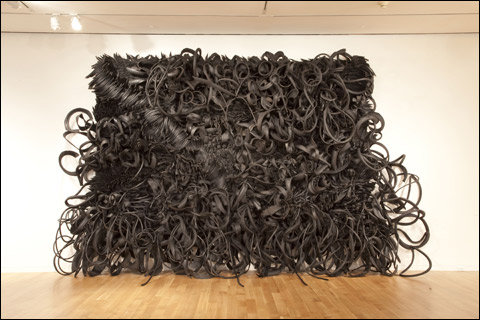
IT’S SO HARD BEING GREEN: Chakaia Booker’s talent is in making everything irresistibly tactile. |
Dennis Kois became director of the DeCordova Museum and Sculpture Park in Lincoln in June 2008, with plans to revitalize an institution that had gotten a reputation for being stodgy. Last year, Kois landed two $1 million gifts to fund purchases for the sculpture park and endow it. When the first gift was announced, in May 2009, the museum also changed its name to the DeCordova Sculpture Park + Museum. All of this signaled that Kois was making the museum's 35-acre park his primary focus and identifying sculpture as a niche that the museum could fill both locally and nationally — because, in part, there are few major institutional players devoted to sculpture. A potential hurdle was that sculpture — making it, shipping it — is pricy. Kois's fundraising prowess in the teeth of the Great Recession suggested that this wouldn't stop him.| “Chakaia Booker: In and Out” | DeCordova Sculpture Park + Museum, 51 Sandy Pond Road, Lincoln | through August 29 |
So, he's made a good start, but what about the art? All of his plans may come down to the taste of the DeCordova's curators. Rachel Rosenfield Lafo, director of curatorial affairs, who had worked at the museum for nearly 25 years, resigned (was pushed out?) in November 2008. Which leaves senior curator Nick Capasso and associate curator Dina Deitsch (plus curatorial fellow Lexi Lee).
Deitsch organized this spring's DeCordova Biennial, which re-energized what had become a tired annual round-up of local talent, as well as last fall's Andrew Mowbray sculpture show and last spring's survey of Ann Carlson and Mary Ellen Strom's videos — both of which featured polished projects undermined by weak ideas. Capasso has organized DeCordova's current survey of New York sculptor Chakaia Booker, "In and Out." It starts off poorly with Take Out (2008). Installed outside the museum's front door, this is a giant empty picture frame that has sprouted a bunch of curly, pointy tendrils made from Booker's signature material, old cut-up tires.
Booker's interest in industrial materials and flowing abstract forms comes out of late Modernist abstraction, but more revealing is her work's affinity with younger sculptor Nick Cave's fabulously decorated costumes. That's easy to miss, because she confines herself to the color black, but she loves flamboyant, gaudy, even clashing patterns that are manifest in her work as a wide variety of textures. Her talent is in making everything irresistibly tactile. This contrasts with much of sculpture today, which, coming out of Minimalism and Conceptualism, is about looking or thinking. But Booker's knack for touch is undermined by her forms. A picture frame — really?
The show ranges in and out of the museum, taking in a pair of sculptures resembling charred house rafters that have been long-term features of the sculpture park, and taking advantage of the museum's unique space, a long underused resource. But Booker tends toward geometric banalities (hoop, helix, S-curve) and hoky clichés (picture frame), and the tires can begin to feel gimmicky. So only a handful of the 30 works here are much good.